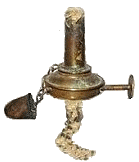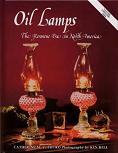
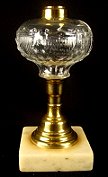


Early Lighting 7
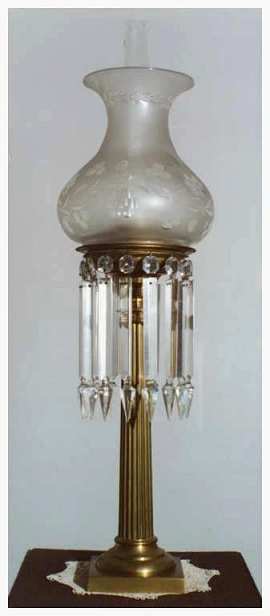 The Cornelius Solar Lamp
Pictured above is a Cornelius (Philadelphia) solar lamp that incorporates the burner mechanism that is the basis for the "famous" 1843 patent. Christian Cornelius became world famous for creating many types of lighting devices and beautiful gas chandeliers that still hang in important houses and public buildings in the US. Cornelius immigrated to Philadelphia from the Netherlands in 1783 and set up business as a silversmith. In 1816 he was listed in the Philadelphia directory as a silverplater, and by 1825 he was also described as a patent-lamp manufacturer. His one son, Robert (1809-1893), was instrumental in expanding the lighting business after 1831. The firm began in a single house, annexing adjoining houses as it grew. While Cornelius solar lamps with the name tag and inscription of the 1843 patent date are fairly common, I know of only one other example of this burner than the example owned by Mr. Baumann. The other example of this particular lamp is the patent model at the Smithsonian Institution! It seems the earliest forms of the Cornelius lamps have not survived the last 150 years intact.
Photo compliments of Mr. Heinz Baumann
Argand Lamps
In Switzerland in the l780s an inventor named Aimé Argand invented an oil lamp burner with a tubular wick that allowed air to flow up through the hollow middle of the wick as well as around the outside of it. It had a circular wick mounted between two cylindrical metal tubes so that air channeled through the center of the wick, as well as outside of it. A cylindrical chimney, in early models of ground glass and sometimes tinted, surrounded the wick, steadying the flame and improving the flow of air. It used a supply of good liquid oil, such as spermaceti whale oil, supplied from a separate reservoir as the fuel. Aside from the improvement in brightness, the more complete combustion of the wick and oil required much less frequent snuffing (trimming) of the wick. This added flow of oxygen made the flame burn brighter than any other lamp previously known anywhere. These lamps soon were produced in great numbers in England and France. Famous Americans such as Benjamin Franklin and Thomas Jefferson as well as other Americans who had traveled to Europe brought Argand lamps back to American soil as they were so impressed with the light they produced. These lamps soon became popular in the United States because of this initial introduction. Between 1785 and 1843 they represented the most advanced lighting in the United States. The Argand burned as brightly as ten candles. In Philadelphia craftsmen made Argand lamps to compete with the imported lamps. The most prolific manufacturers there were John Leadbeater and Christian Cornelius. The first to make this type of lamp on American soil were craftsmen such as jewelers and copper plate makers who made lamps only as a sideline. One of the earliest manufacturers of the lamps was Peter Geley. The Argand was the lamp of choice for those who could afford them until about 1850. The next big change in lamp technology were lamps that burned kerosene. These lamps used a flat wick in a cup with a bellied chimney. Kerosene was considerably cheaper than whale oil, and many Argand lamps were refitted to burn kerosene.
|
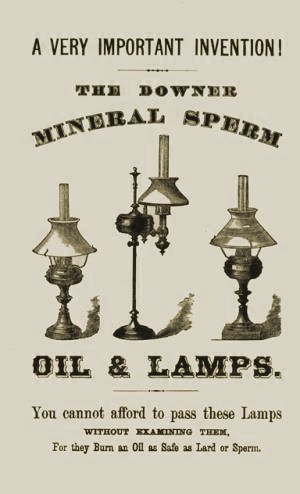
Other Lamp Types & Fuels in the pre-Kerosene Era
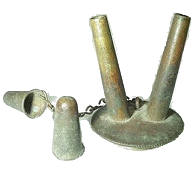 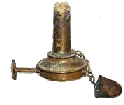 fluid burners
Many whale oil lamps were converted to burning fluids when whale oil became too costly. The burner for these fuels differed from the upright tubes of the whale oil burner. Fluid lamps had one or more tubes. Those with more than one were set at angles almost like spread fingers. Often little caps to keep the fluid from evaporating when not in use were attached to the burners by small chains. Fluid lamps have tubes that stick up higher than those on lamps designed just to burn whale oil. See the photo on Early Lamps 6 page. Round cotton wick would be in each tube. Other types of lamps that burned the vapours produced by fluids also where used during and after the hayday of whale oil. See the photo below.
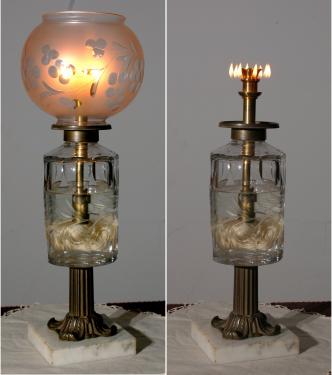 The most commonly used term for this lamp is “burning fluid vapor lamp”. The fuel is a mixture of alcohol and turpentine in the ratio of 4:1 (called “burning fluid”). To start the lamp, alcohol is filled into the trough (or small bowl-like dish) below the burner head and is ignited. The alcohol flame preheats the burner head and the vaporization of the burning fluid brought to top of the burner by the capillary action of the thick wick is started inside. The fluid vapor exits through 12 pin-size openings and burns like ordinary gas. The heat of the gas flames will sustain the vaporization process and hence, the lamps are often referred to as self-generating gas lamps. The lamp is American and is from the 1840s. Kind thanks to Mr. Heinz Baumann for the photo and discription.
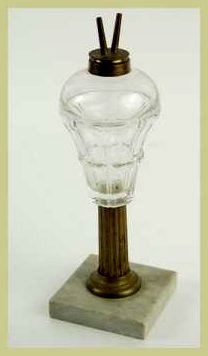 Often the lamps that were used to burn whale oil were also used to burn other fluids such as coal oil, benzine and camphine. Camphine is a very pure distilled or rectified oil of turpentine. The name is also applied to a mixture of this substance with three times its volume of alcohol and sometimes a little ether, used as an illuminant. Camphine is highly volatile and explosive and many people lost their lives when lamps exploded!
 Coal oil is a specific oil shale oil used for illuminating purposes. It is sometimes confused with kerosene or lamp oil, but coal oil was obtained from the destructive distillation of cannel coal, mineral wax, and bituminous shale, and hence called coal oil. A special type of coal known as *cannel coal (classified also as terrestrial type of oil shale) is required to produce it.Coal oil was first produced in 1850 by James Young on the Union Canal in Scotland. He was the first to patent the process of distilling this cannel coal into kerosene. This industry thrived in Scotland creating much wealth for James Young.
 * 'Cannel' or candle coal burns with a bright flame.
It was once used as a source of illumination as well as heat.
Although Americans did know something of petroleum deposits as early as 1700 oil never really entered into serious trade until about 1849 when Samuel M. Kier of Pittsburgh began selling "Kier's Petroleum or Rock Oil. He did not sell it as fuel however. He hawked it as a medicinal compound for its " Wonderful Curative Powers". However there were others who were already pursuing other ends for this magical black gunk. Firstly James Young of Glasgow, Scotland, began distilling lubricating and illuminating oils from a petroleum spring in Derbyshire, England in 1847. Also in Canada one Abram Gessner distilled kerosene from coal in about 1846. Gessner patented his process in the U.S. and sold his rights to the North American Kerosene Gas Light Company of New York. They began commercial manufacture in 1854. Amazingly by 1859 there were between 50 and 60 companies making kerosene from coal, shale, and other carbons. There was no stopping the huge change it brought and in no time at all these products replaced older lamp fuels like whale oil, camphine, and lard. In 1859 E. L. Drake made his momentous oil strike in western Pennsylvania, and the supply of crude oil rapidly grew over night. By 1860 more than 200 patents had been granted on kerosene lamps and within only years kerosene became the world's principal illuminant.
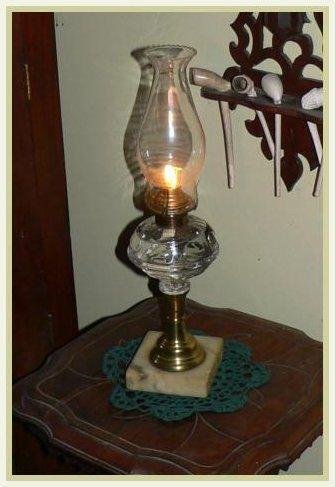 An 1860s lamp in our collection.
After the Civil War things changed rapidly as the Industrial Revolution gathered steam. Science and technology made great gains in a very short time. This was a new era for lighting and I could fill books with the new advances in illumination after the Civil War. With this boom came hundreds of new companies making lamps in mass in full scale factory settings unlike the previous lamps which were made largely by hand by highly skilled craftsman or in small factories. The kerosene era lasted until the 1930s in actuality because in rural areas electricity came slowly. Crude oil was soon discovered in many parts of the world making it all the more the fuel for further change.
 We will not address lighting devices in the kerosene era in any detail on this site as it is such a broad subject. We have limited these pages to early lighting types and fuels. We hope you have enjoyed this over view of early lighting. If you would like to learn about the grand era of kerosene, I highly recommend the three large books by Catherine Thuro for a fantastic survey of kerosene era lamps The titles are : The Kerosene Era in North American, Oil Lamps II; Glass Kerosene Lamps, and Oil Lamps 3 ; Victorian Kerosene Lighting, 1860-1900. They are lavishly illustrated with wonderful photos and reasonably priced. I could not possibly begin to cover that material here nor have I the knowledge to do so. Please follow some of the links on these pages and you will find even more information?
Kind regards,
Beth Maxwell Boyle
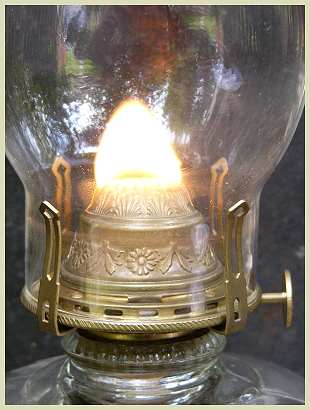 Links
learn more about fluid lamps!
 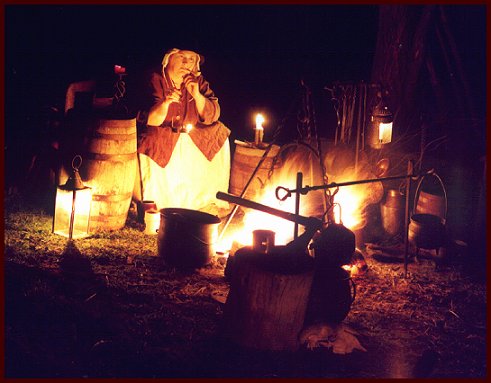 |
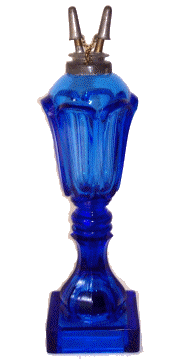
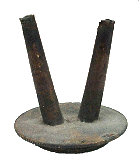
Copyright 2008 , Jim & Beth Boyle, All Rights ReservedNo part of this website may be used for any purpose ( including using images ) without written consent from The Rams Horn
